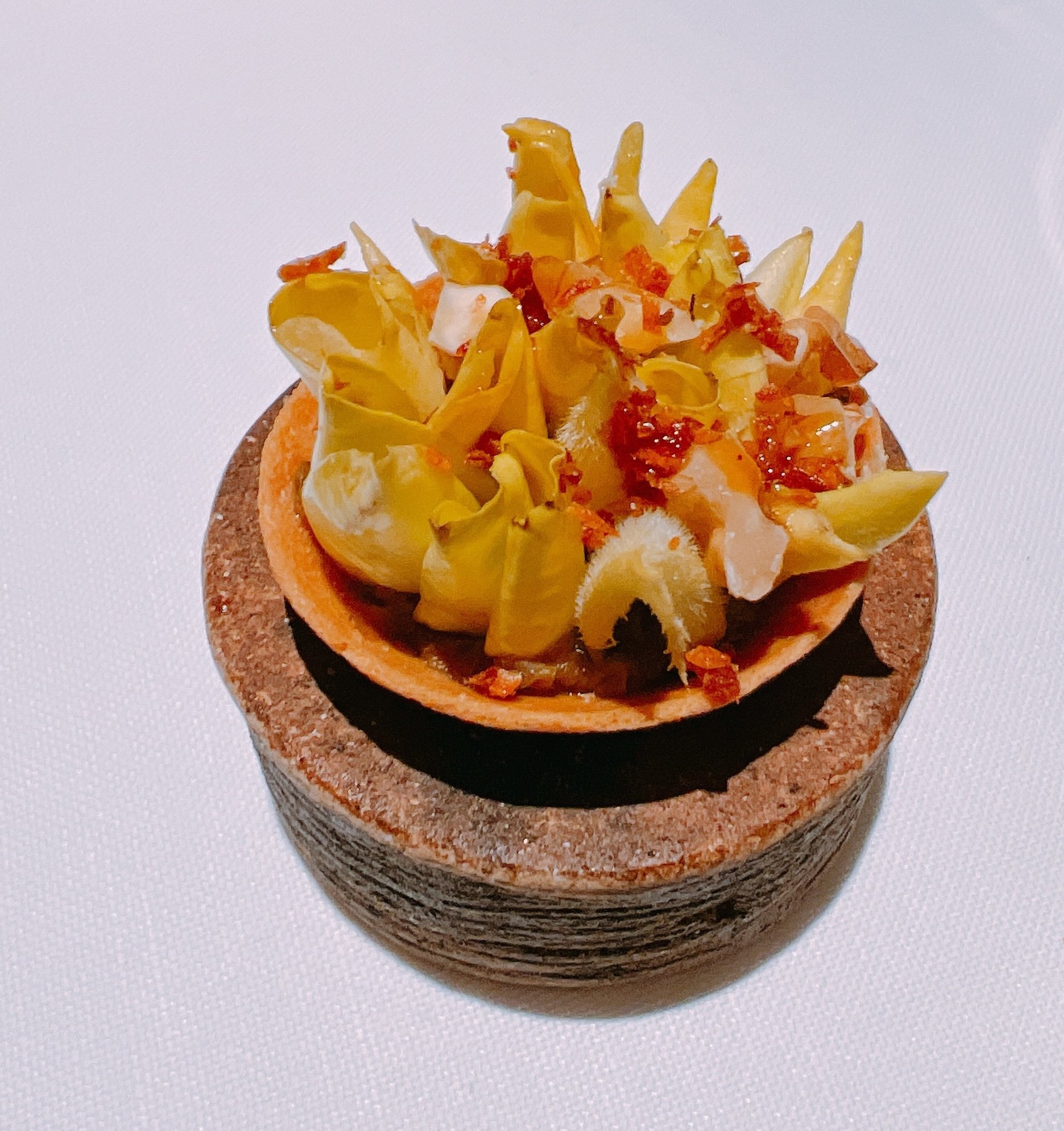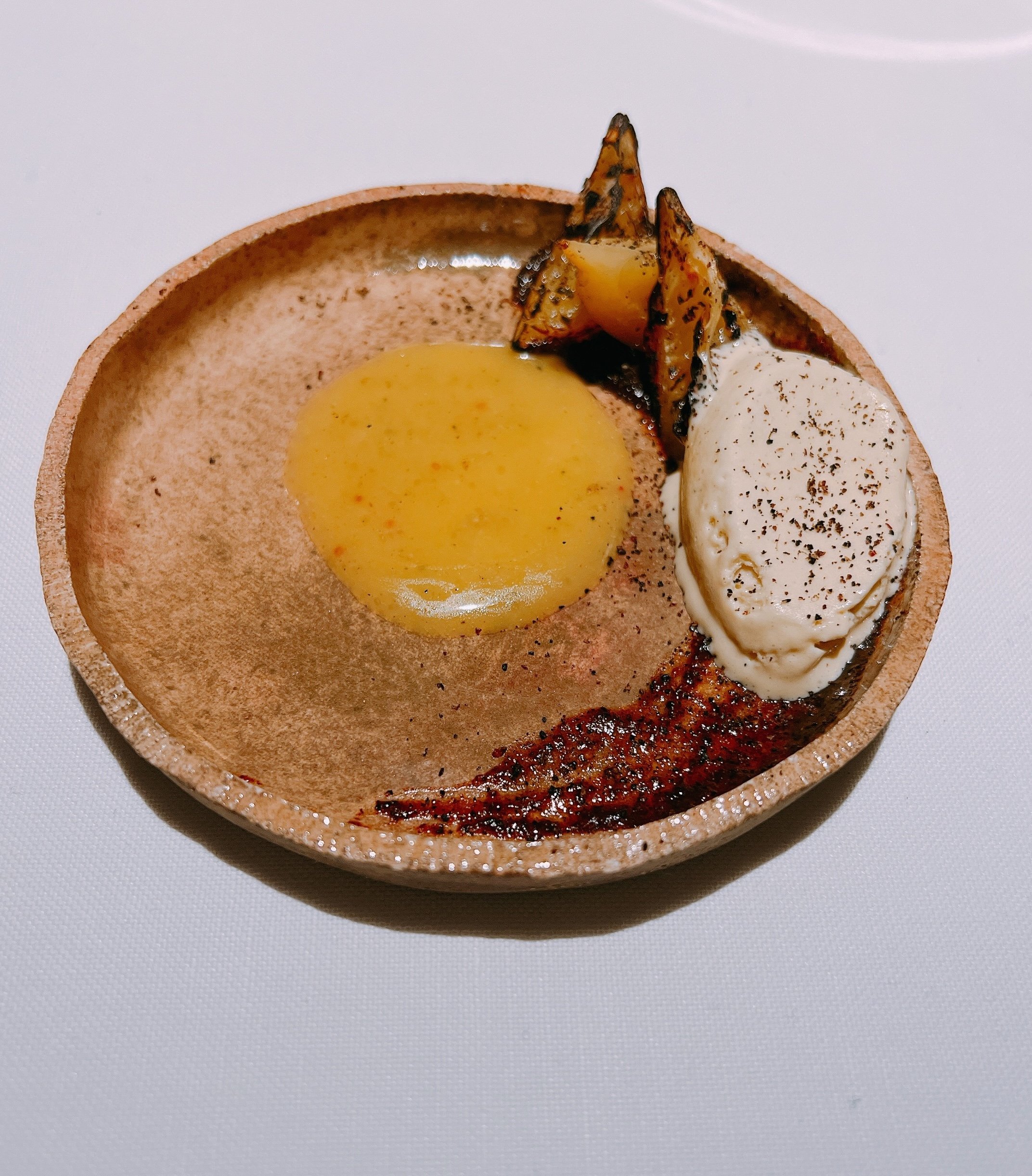Clos des Sens - Annecy
Rating: 17/20
Where: Annecy, France
When: Dinner for 2 on 22 March 2022
Cost per Person: Tasting menu 238 Euro / Wine pairing 145 Euro
Accolades: 3 Michelin Stars
Why: Technically and intellectually impressive dishes often just using a single ingredient
Clos des Sens is co-located with the hotel of the same name (and owner) in the oldest part of Annecy, a city bordering Lake Annecy at the foot of the French Alps. The city reminded us of Geneva, also located on a lake with a view of the Alps, and in fact only 40 minutes away by car.
The dining room is pretty dark, with black walls, with only the open kitchen providing a significant source of light. Opposite the kitchen, panorama windows look out on Annecy, although at 8pm in March, this view amounted mostly to darkness with a few city lights. The chef was not present when we dined, since the 2022 Michelin awards for France were announced at the very same time.
Menu choices were either seven or nine surprise courses, with no a la carte option. We went for the nine course menu which has one more savory and one more dessert course. Wine pairings are available as well.
The menu was pescatarian by design and featured only local lake fish and local produce. Many of the vegetables were from the garden adjacent to the restaurant. Whereas some fine-dining restaurants such as the French Laundry contort themselves to not repeat any major ingredients throughout the meal, almost the opposite was true here - many ingredients made two or even three appearances. I'm not sure whether that's by design or whether the local ingredients in March are just not that plentiful.
Amuse bouches started with variations of mushrooms - raw, cooked, powdered and as a cracker 18. A pike mousse on a cracker followed 17, then fera liver 16. Fera is a local fish found in nearby Lake Geneva, it tastes very light, but the liver unsurprisingly was more intense. The last bite was sage, celery and herbs from the garden, a very refreshing dish 18.
Bread was fine, not great, and served cold. Oddly, no butter or similar spread was available, instead we were given peppercorns from the garden.
Two-week cured Fera with horseradish sauce was the first "real" course. The fish was a bit on the chewy side, and the horseradish sauce could have used a bit more kick, and possibly been a bit thicker. But overall an enjoyable dish 17.
Next were variations of pike and radish. Several different kinds of radishes, some pickled and some raw, were served as a kind of salad with pike prepared three ways: dried and fried as a chip, smoked and (almost) raw. Lots of different textures at work here, some better than others. This could have used a tad more dressing 17.
Course three had more variations on mushrooms. Raw mushrooms piled into what looked like an upside-down pine cone - very pretty, and no doubt time-consuming to construct. These covered a cooked mushroom, mushroom mousse and mushroom jelly. On the side was a small cup of heavenly mushroom broth (with plenty of cream). Hard to judge the different components, the broth was close to perfect, but picking up the raw mushrooms with tweezers (where are chopsticks when you need them?) got old fast, maybe 17 on average.
Next we were back to fera, this time cooked sous-vide for 45 minutes at a low temperature, i.e. fully cooked but with an almost raw texture. This was served with radishes providing some nice crunch and a local herb "curry". We noted flavors of ginger and lemongrass. Our server described this dish as "spicy" and paired a German Riesling with it, but we didn't notice any spice, just herbaceousness 17.
Another course with pike followed, accompanied by spinach prepared three different ways, raw, cooked and pureed. The fish was overcooked, but the accompanying spinach was lovely 17.
This was the last savory course, and the transition from savory to sweet was done in an ingenious way. We were served an endive, complete from stem to flower. The endive was cooked (possibly baked), and topped with chopped almonds and honey. You were supposed to eat the endive starting at the end of the stem, working up towards to the flower part. The stem was bitter and savory, and this slowly transitioned into sweetness at the flower end. Moving from salty to sweet in a single ingredient - what a brilliant concept! At the end there was a small tartlet containing just endive flowers. So much for the high concept, but how did it taste? First, this was a pretty substantial dish for what amounts to a palate cleanser. Something a bit lighter might have been more appropriate at this stage of the meal. And while it's easy to appreciate the cleverness of the dish, I probably wouldn't order this dish for its taste (especially the bitter part). So maybe a generous 16.
Next was the cheese cart, bulging under the weight of the many kinds of cheeses present. All were local or from Switzerland, our selection included several winners, so we were quite happy. We particularly liked a Swiss Gruyere and a local blue cheese similar to a Roquefort.
More cheese was in the next "dessert" (in quotes since all desserts had some savory components). It was ice cream of Reblochon (a local cheese) with rose hip puree and rose hip ice. I thought the cheese ice cream was delightful, the very weak taste of Reblochon actually being used to its advantage here, so that other flavors can shine 18.
Next came a roasted Swiss lemon (both bitter and sweet), alongside pepper ice cream, and a sauce made from lemon and the restaurant's own honey. Pretty good, the lemon was a surprisingly rustic ingredient 17.
A chicory meringue with a chicory cracker came next - a coffee-flavored dessert without any coffee. I liked it a lot, this was nicely different from the typical coffee and/or chocolate flavored desserts one often sees at this point 18.
Second to last, an ice cream sandwich whose look recalled the mushroom variation served at the very beginning, close to four hours ago 16. And finally a madeleine that was fine, but a bit plain 15.
Overall: I appreciated that most ingredients were local, often from the restaurant's garden (which is worth a visit if you have some time before or after your meal). However, there is a lot of repetition of ingredients, often by preparing them different ways in the same dish. While it's intellectually impressive - making a complex dish with essentially just one or two ingredients - the result is not necessarily mind-blowing from a flavor-perspective. So the technique on display might be three stars, but the overall experience is more like a 17.




















